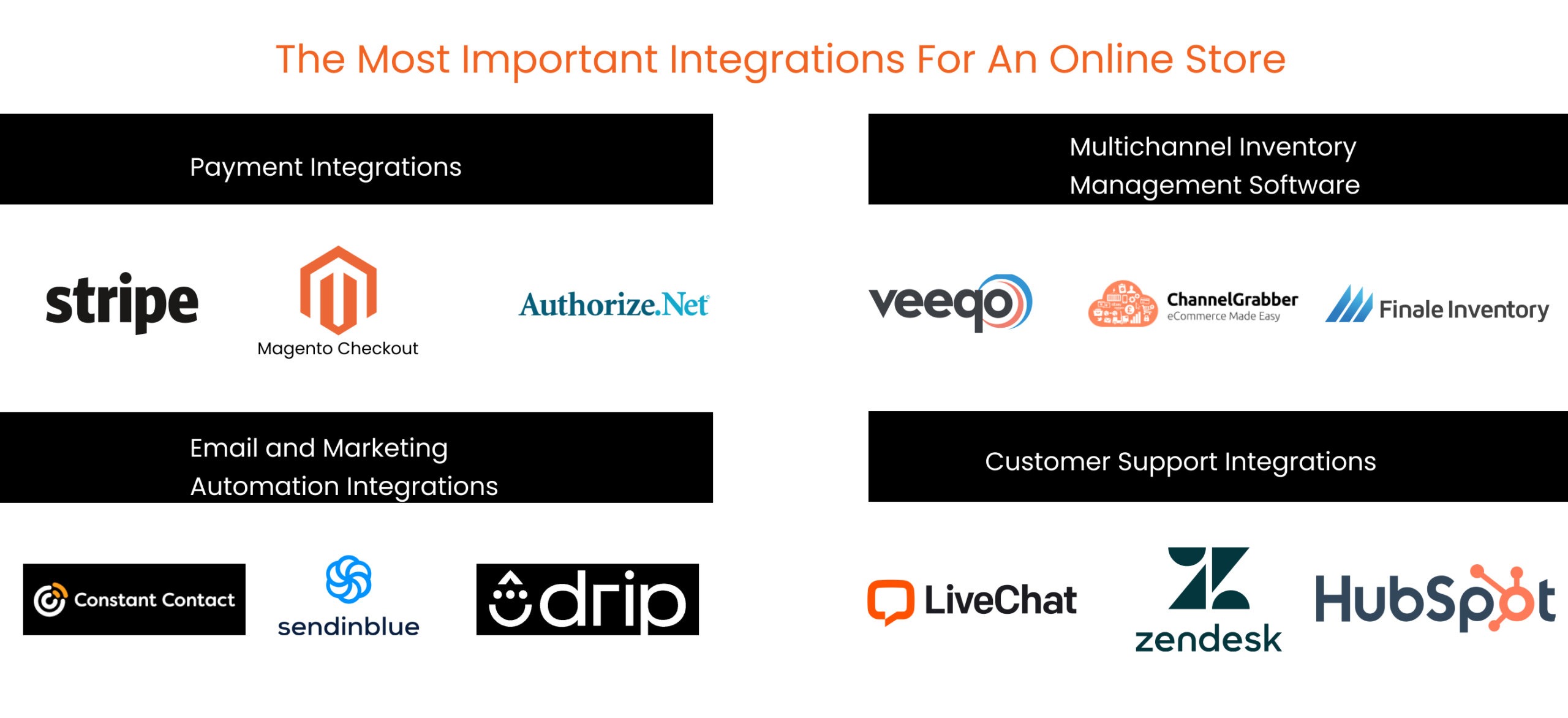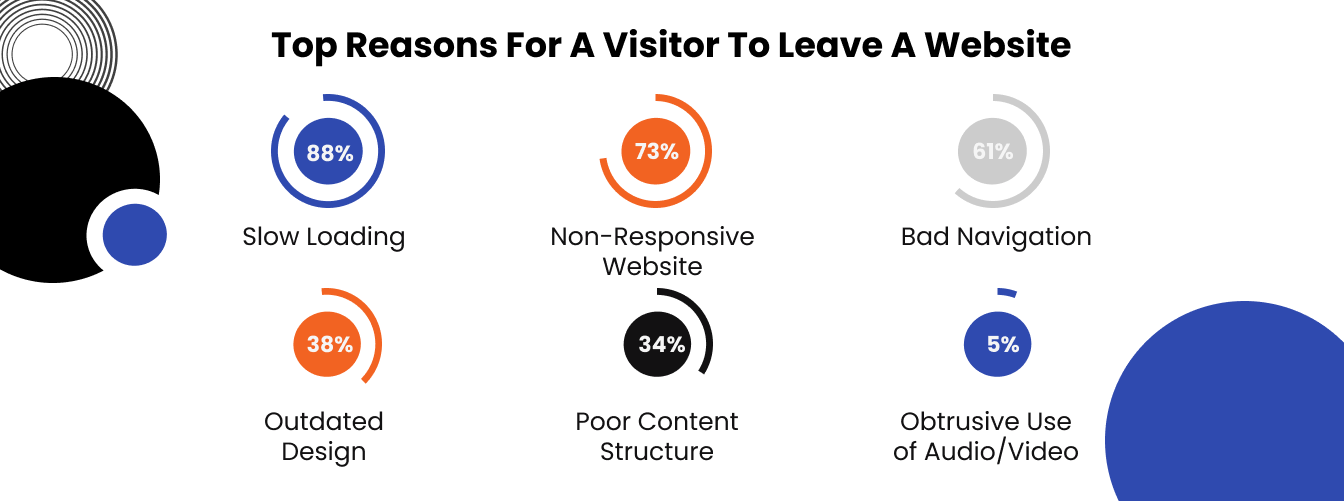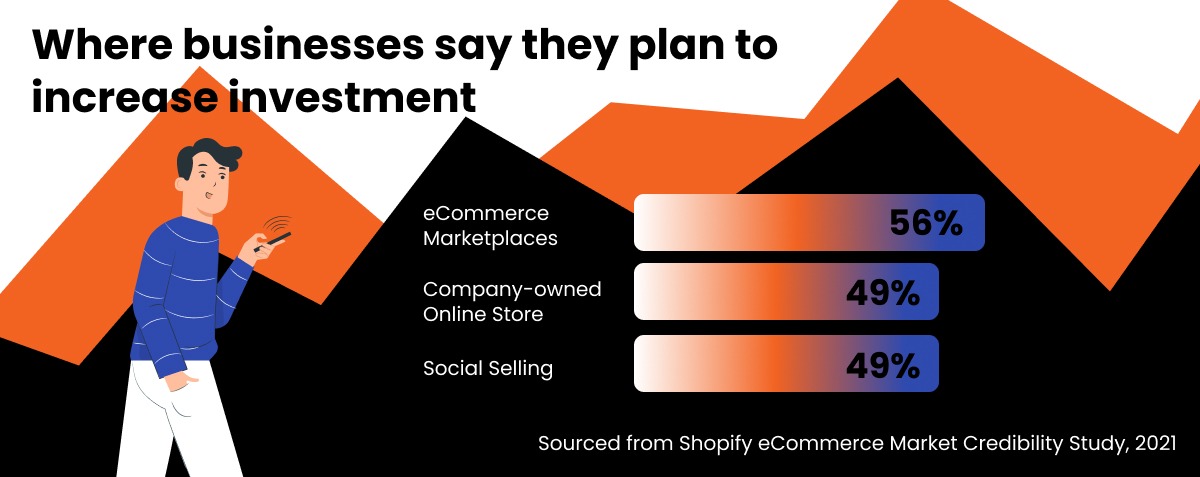The expanding eCommerce industry offers incredible growth opportunities to entrepreneurs, inspiring them to start their eCommerce businesses.
Indeed, the online retail sector represents steady growth, and the tendency is expected to preserve. The chart below introduces the online retail market growth forecasts from 2021 to 2026. The respective numbers promise to jump from over $6 trillion in 2023 to $8 trillion in 2026.
Furthermore, the ecommerce revenue in 2023 made $910 billion in the U.S., while in 2024, it is likely to surpass $1 trillion.
The examples of prominent industry giants, such as Amazon, eBay, and Etsy, further spur retailers worldwide to step into this lucrative market segment. However, while the demand and market potential are high, competition is also fierce.
So, how do you start an ecommerce business to drive your company to new heights?
Primarily, you should combine a convincing web presence with sturdy ecommerce platforms, relevant offerings, and superior service.
To be more specific, you should understand the following:
- How the ecommerce business operates;
- How to arrange a legal side;
- What business model you should follow;
- How to build an eCommerce site;
- And how you would make your business thrive.
We are here to help you explore all these vital aspects.
- eCommerce Business: How Does It Work
- Legal Steps to Launching an eCommerce Business
- eCommerce Business: Where to Get Goods for Your Online Store
- How to Build an eCommerce Site
- How to Grow Your eCommerce Business Successfully
- In Conclusion
Get an eCommerce Expert Consultation
Our Adobe Business Practitioner will audit and optimize your site for robust performance.

eCommerce Business: How Does It Work
In a nutshell, an ecommerce business implies purchasing and selling commodities online. Its online stance is shaped by a digital platform and usually a website, a mobile application, or both. Merchants set up an eStore, where visitors can explore products, compare prices, select favorites, and buy what they wish.
An ecommerce site acts like a storefront, representing the shop’s offerings, product descriptions, images, and other pieces of content. Users can put the chosen items into their virtual shopping carts, proceed to checkout, and insert their shipping details.
Once a purchase is completed, the eCommerce platform generates an order, and the merchant fulfills it by packaging and delivering the pieces to the consumer’s indicated address. These basic capacities usually come along with client support, order tracking, and returns processing.
Successful eShops also leverage marketing strategies such as digital advertising, social media promotion, and search engine optimization to cut through a fiercely competitive clutter.
The overall success of an online enterprise relies on a consumer-focused site, optimized logistics, safety, and a competent marketing strategy.
Legal Steps to Launching an eCommerce Business
How do I start an ecommerce business from a legal perspective?
Businesses are legal entities established at the state level. Therefore, they must arrange their activities with the states where they intend to work.
We’ll go through ecommerce business registration in the USA, Europe, and the UK.
How to register an eCommerce business in the USA?
A business owner in the USA must comply with federal and state-specific requirements. Here is a general guide:
- Register with the IRS.
You must obtain an Employer Identification Number (EIN) through the Internal Revenue Service (IRS). This number is required for tax purposes for a specified number of businesses, including those that hire employees.
- Sales tax registration:
If your type of business is required to collect sales tax, you should register with the respective state department for a permit.
- Business licenses and permits.
Explore which licenses or permits are required by local, state, and federal regulations in your location. These documents are necessary for your enterprise to run legally; they vary in different states and may include zoning permits or industry-specific licenses.
- Open a business bank account.
Having a dedicated business account is convenient as it allows for separating your personal and business finances and monitoring business expenses and income.
How to register an eCommerce business in Europe?
How to open eCommerce business in a European location?
If your business has an EU establishment, you will need to fulfill the following:
- Register with local authorities.
Depending on where exactly you plan to operate, you should register your business with the national or local registry.
- Obtain a VAT and EORI number.
Most European countries apply a Value Added Tax (VAT). You should register for a VAT number to collect and remit VAT on sales. EORI stands for Economic Operators Registration and Identification Number and is used for customs purposes.
- Employment regulations.
For merchants who plan to hire employees, meeting employment rules in the respective country, such as contracts, benefits, and social security contributions, is obligatory.
- Online selling regulations.
Check the online selling regulations to ensure your business practices comply with them. These rules may include consumer protection laws, distance selling regulations, and electronic commerce regulations.
- EU compliance and import regulations.
The goods you are selling must be compliant with EU legislation. The appropriate labeling and documentation are mandatory. Also, familiarize yourself with customs regulations if you plan to ship goods across the EU border.
How to register an eCommerce business in the UK?
For businesses with a UK setup, the following legal steps are required:
- Register with Companies House.
For organizations having a limited company structure, registration with Companies House, the official register of companies, is obligatory. You can complete this procedure online.
- Get a Unique Taxpayer Reference (UTR).
Register for a Unique Taxpayer Reference (UTR) with HM Revenue & Customs (HMRC).
This is necessary for tax purposes and can be done online.
- Establish your VAT registration.
VAT applies to businesses with turnover exceeding the VAT registration threshold. Check whether yours is subject to VAT and, if yes, register with HMRC.
- Digital Services Tax (DST).
The UK has initiated DST for a specified range of digital services. Find out whether your business falls within the list.
No More Lost Customers!
We offer tech audit and implementing of new theme with a hot feature set to rekindle customer interest and drive additional sales.

eCommerce Business: Where to Get Goods for Your Online Store
The appropriate goods will help your business thrive. The questions are, how to identify the winning inventory for your shop, and where to take it? The following subsections seek to unveil the answers.
Which eCommerce Products Sell The Best?
When addressing how to start an eCommerce company, you should strategically approach the selection of goods for your eShop. The picture below showcases the top-selling categories in the U.S.:
| Top Online Shopping Categories | Revenue |
|---|---|
| Toys, Hobby, and DIY | $256 billion |
| Fashion | $164 billion |
| Electronics | $131 billion |
| Beauty, Health, Personal, and Household care | $93 billion |
| Furniture | $90 billion |
However, these groups are too general and multifaceted to jump blindly into any of them, based merely on your personal preferences.
To narrow down your choice, check the products from the above-mentioned categories experiencing the highest demand throughout 2023.
- Power banks. These items grant users the freedom to charge their portable devices on the go, hence their immense popularity, witnessed by a monthly Google search volume of 639,000.
- Model train sets. Model trains became a lovely leisure activity for the whole family. Modern sets are available in an overwhelming variety, having average monthly searches of 40,500.
- Tumblers. A convenient and eco-friendly accessory for outdoor activities, the U.S. tumbler is forecasted to make $1.4 billion by 2027.
- Matcha. Originating in East Asia, this ground green tea leaf powder provides significant health benefits combined with enhanced mental clarity. It gets over 799,000 searches per month.
- Signage. These trendy home-décor elements are highly sought after today. 135,000 monthly searches witness their popularity.
- Hair Oil. Personal care products are on the surge and the products that make hair soft and hydrated become best-sellers. Confirmed by the monthly search volume of 119,000.
- Cargo Pants. Clothing that looks trendy and provides a comfortable fit and practicality has become the number one consumer choice. The search volume for cargo pants is 923,000 per month.
- Furniture. Moving to a new place or redesigning the existing one requires additional furniture. The U.S. furniture niche is expected to grow at a 2.17% rate till 2025.
- Wedding dresses. The wedding apparel niche has showcased steady growth throughout recent years. Experts forecast it to reach $69.9 billion by 2026.
- Mobile electronics accessories. The popularity of portable smart devices is booming, which spurs the need for associated accessories. Earbuds, covers, protectors, travel cases, and more complement smartphones and expand or improve their functionality. The segment’s growth forecasts indicate a whopping $111 billion by 2025.
Where Do I Take Products For My Store?
When exploring how to start an ecommerce business, consider several methods to source your goods.
Resell existing products from the available suppliers
Reselling can save costs and is straightforward to start. You can select suppliers from the online directories and listings. Contact the chosen vendor, order pieces, and transport them to your storage location. When a consumer picks an item, take care of the delivery. By extending your supplier network and building trustworthy rapport with them, you’ll gain opportunities to scale efficiently and secure a resilient supply chain.
Use dropshipping
If you don’t want to keep stock, dropshipping may be an option for you. Here’s how this business model works. When a client places an order, you buy the piece from a third-party vendor, who then delivers it directly to the recipient. This approach relieves you from the hassle of inventory keeping and shipping and doesn’t require many upfront expenses. Furthermore, it empowers you to provide an extensive array of goods.
Sell your own products / engage with a manufacturer
Manufacturing products grants you control over all their parameters. This method, however, requires significant investment and can be complicated to scale. Premium, handmade pieces can become a feasible option for keeping operations manageable.
Another way is partnering with a manufacturer. Again, the approach is rather resourceful. However, it can bring huge dividends if you build your brand.
How to Build an eCommerce Site
There are diverse types of eCommerce platforms, including marketplaces and standalone sites. Should I opt to construct my own shop? Or should I sell my goods through a prominent marketplace? If you are facing these questions, read further to discover each opportunity’s weaknesses and strengths.
Personal store vs. marketplace: Pros and cons
Marketplaces and individual ecommerce platforms alike carry their upsides and downsides.
Marketplace
| Pros | Cons |
|---|---|
| Inherent audience. Marketplaces grant you access to their vast clientele, which you otherwise may be unlikely to discover. | Lack of control. There are fewer things you can influence when selling through a marketplace. Consumer journey, product presentation, and other factors remain under the marketplace’s control. |
| Marketing cost minimization. Marketplaces undertake the necessary activities to drive traffic to their sites. Therefore, you can save on your marketing efforts. | Fees. Vendors pay various fees to the marketplaces, such as transaction fees, listing fees, and more. These payments can make about 30% of your selling price. |
| Brand awareness growth. Offering your products in a marketplace with renowned brands can help enhance your brand exposure and build consumer trust. | Competition. At the marketplace, you’ll have to fight for the audience’s attention with multiple other brands. Depending on your niche, this could be challenging. |
| Easy start. Joining a marketplace is rather simple, regardless of your technical expertise. | Marketplace dependency. While the marketplace does the bulk of marketing activities, it can adversely affect your business when a marketplace changes its policies or algorithms. |
| Access to handy tools. Marketplaces offer merchants a suite of tools to improve their work. They can include goods catalog optimization, consumer insights, or other analytics. | Consumer data ownership. When selling through a marketplace, you don’t access your clients directly. Neither do you own their data. This can impede your customer rapport. |
Now, let’s proceed to discover the pros and cons of a personal eCommerce shop.
Personal Site
| Pros | Cons |
|---|---|
| Brand сontrol. When you create an ecommerce website of your own, you are the master of all brand communication and consumer path. | Marketing. Without an inherent audience and steady traffic, you’ll need to establish your marketing from scratch. |
| Higher profits. You don’t have to pay third parties for the placement of your assortment. Lower expenses lead to greater profits. | Technical skills. Maintaining your own web space requires technical expertise. You may need the help of a third party to bridge this gap. |
| Mastering consumer information. All the information you collect about your visitors remains at your disposal. You can use it for precious insights and strategic decisions. | Payment system. Establishing reliable payment processing is rather a challenge than a drawback. A laborious process, it can be better to entrust to a professional partner. |
| Flexibility. As a website owner, you are free to sell anything you want on your preferred conditions. Change offers, goods, prices, and marketing activities according to your tasks and needs. | Delivery. Depending on your selected business model, you may be responsible for shipping of the ordered goods to the recipient. This can cause additional challenges, especially if you ship internationally. |
| Improved consumer relationships. When consumers buy from your site, you can directly interact with them, building trust and loyalty. | Consumer loyalty. You’ll have to establish client rapport from scratch. For a start, visitors may be reluctant to buy at an unknown place. |
To sum up, developing an eCommerce website of your own grants higher flexibility and greater opportunities for a merchant. While engaging with an existing marketplace may seem easier and less expensive at first glance, it poses certain restraints in the long run. The final decision will depend on your business goals, but you should remember that a personal site gives you wider opportunities for implementing your brand strategy.
Constructing a Personal eCommerce site
How to make an eShop painlessly and efficiently?
You can opt for a custom-made site or leverage out-of-the-box solutions. Let’s explore which path is more beneficial.
Custom vs. Ready-Made Site
A tailored site sounds enticing since it considers all your specific needs. However, is its transcendence over a ready-made solution beyond questioning? In fact, entrepreneurs often prioritize out-of-the-box solutions for their efficiency and ease of implementation. We’ll briefly go through the benefits of utilizing the existing ecommerce frameworks.
- Cost and time investment. Implementing a custom solution is typically more expensive and laborious than a ready-made one.
- Maintenance. Tailored sites can be complex, requiring ongoing maintenance and updates. Existing solutions often come with built-in features and updates.
- Time to market. With an existing framework, merchants can quickly get into e-commerce, establishing and launching their operations seamlessly.
- Marketplace features. The top ready-made solutions have inherent ecommerce features, empowering wider functionality and simpler start for merchants.
Best eCommerce Website Development Platforms
Once we’ve discovered that an out-of-the-box solution can help establish a winning eCommerce business, let’s look at the most prominent examples of the eCommerce platforms.
We’ll focus on Magento and Shopify as some of the most practical and widespread ones. There is also another reason for our selection, but we’ll reveal it a bit later. Read on!
Both Magento and Shopify fall within the top ten global solutions and boast impressive upsides.
- Shopify.
Shopify is easy to establish and operate while delivering solid opportunities for merchants. User-focused store setup, safe payment options, customizable themes, and mobile responsiveness make it perfect for online retailers. The platform carries inherent tools for inventory handling, order processing, and marketing. It is excellent for small-to-medium enterprises.
- Magento.
Users praise Magento for a multitude of potent ecommerce features. Flexible product management, SEO capabilities, numerous extensions, plentiful themes, and inherent marketing and analytics tools are just some of its abundant strengths. The platform is flexible and scalable to address the needs of any ecommerce company.

Don't Let Peak Seasons Overwhelm Your Site!
Say goodbye to site crashes during discount seasons. Hire Magento expert and Adobe Business Practitioner whose will audit and optimize your site for robust performance

How Much Does eCommerce Website Development Cost? A Real Example
You can confidently pick any of the described platforms, and it will help you drive your eShop. However, you need to know how much investment the ecommerce site development will require.
To shed some light on the price composition, we’ll share an example of our recent project.
- Project purpose:
Our team constructed an eCommerce website for a leading supplier of kitchen and catering equipment in the European region.
- Project team:
- Back-end developer
- Front-end developer
- Designer
- QA
- PM
- Project stages:
The development procedure involved the following stages with the respective team involvement:
| Stage | Role | Hours |
|---|---|---|
| Design Implementation | Front-end developer | 190 |
| Magento instance setting up and configuration | Back-end developer | 12 |
| Theme installation | Front-end developer | 20 |
| Server configuration | Back-end developer | 12 |
| Frontend implementation | Front-end developer | 390 |
| Backend implementation | Back-end developer | 180 |
| Mintsoft WMS sync | Back-end developer | 72 |
| API INTEGRATION | Back-end developer | 50 |
| Accounting | Back-end developer | 8 |
| Payments | Back-end developer | 8 |
| QA | Back-end developer | 85 |
| PM | 110 | |
- Project result:
Ultimately, we built an efficient and functional ecommerce space, with a team of five people, for about 1,5 months. The rough total cost falls within $19k – $20k.
How to Grow Your eCommerce Business Successfully
Addressing how to start an eCommerce company is only part of the way. A significant portion of your concerns and challenges lies in the area of how to make the business grow.
The opportunities to achieve business expansion are abundant. Here, we’ll focus on the essential mistakes a site should avoid and a reliable strategy that can lead your ecommerce business to prosperity.

Common Mistakes That Kill eCommerce Sales
Prioritizing the following factors will help you avoid the typical mistakes and facilitate conversions on your site:
- Mobile-focused design. About 7.5 billion people worldwide use mobile phones. With the expanding role of m-commerce, a mobile-oriented arrangement is mandatory for an online shop. Enable your visitors to explore your space from any device effortlessly.
- Site operation. Visitors favor fast-operating sites. Every extra second of loading time costs you about 4.42% conversions (within 0-5 seconds interval). Optimize your store for a seamless user experience.
- Checkout procedure. Complex checkout may lead to cart abandonment. The optimal checkout process should include 5 steps and up to 8 form fields to fill out. Ease this final step for your clients, and they will likely push a “purchase” button.
- Payment options. Consumers may have varying payment preferences. Multiple payment options and plans, including credit cards, digital wallets, and post-purchase payment, can extend your clientele.
- Delivery time and options. Shipping is a paramount compound of the purchasing experience. Inform your visitors early about the delivery options and terms that you offer.
Build an eCommerce Marketplace
How to start an eCommerce business efficiently? Run a marketplace!
Combining multiple sellers in a unified place is a lucrative strategy with convincing upsides.
- Revenue source. Gain profits through transaction fees, subscriptions, or other monetization strategies.
- Wide reach. Engage with a global audience and build your brand recognition.
- Abundant product offering. Provide a vast range of products without the hassle of extensive inventory handling.
- Scalability: Expand the marketplace by welcoming new sellers and broadening product categories.
- Monetization. Discover additional monetization opportunities, like advertising, premium features, data services, and more.
How to open an eCommerce business based on the existing platform? Leverage Magento or Shopify!
We’ve already disclosed part of the benefits of these remarkable ecommerce frameworks. Now, let’s proceed to the cherry on the cake. Both Magento and Shopify allow for the quick transformation of an ecommerce site into a multi-vendor marketplace.
The platforms deliver excellent functionality and flexibility to make the transformation effective and run a winning marketplace.
Magento is packed with advanced extensions intended to rebuild your Magento site into a stellar multi-vendor marketplace. These extensions integrate smoothly and allow vendors to enhance their work.
Some of the top choices include marketplace multi-vendor modules by TrueMart Team and Webkul.
In Conclusion
Launching an eCommerce business is undeniably a promising opportunity for entrepreneurs. The industry is expanding, while technology advancements allow for the implementation of numerous strategies to master the digital environment.
How to start an eCommerce company seamlessly? Identify your goods and niche, secure the legal side, and develop a reliable and appealing site while avoiding common faults.
The robust ecommerce frameworks, such as Magento and Shopify are superior solutions for an ecommerce business. Moreover, they empower owners to transform their sites into multi-vendor marketplaces. This, in turn, opens new horizons for business expansion and revenue generation.
Partner with trustworthy professionals to cover technical aspects and focus on your strategic goals. WebMeridian has tremendous experience in Magento site development. We can build your store from scratch, optimize it, or transform it into a marketplace for maximum business efficiency.






